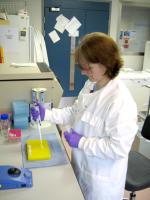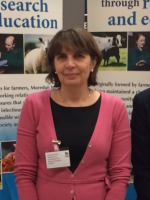
Work Package Livestock production, health, welfare and disease control
Introduction
The accurate diagnosis or detection of pathogens responsible for endemic (common) and emerging (relatively new to UK) diseases in livestock species in Scotland has major economic, environmental and animal health and welfare benefits for the nation. The research focusses on the most common diseases of livestock resulting from infection with bacteria, viruses and parasites, some of which can also cause infections in humans. The specific disease areas that have been targeted for the development of new or improved diagnostic tests, or detection tools, have been identified following discussion with key industry groups or through seeking the opinion of farmers, veterinarians, producers and animal health companies. The research has also been informed by Scottish Government policy as described in the Scottish Rural Development Programme 2014-20 priority areas to enhance and support rural communities, businesses and economies, as well as protecting the environment and addressing the impact of climate change.
Aim of Research
To develop novel tools and approaches to improve diagnosis of the most economically important endemic diseases of livestock in Scotland, the UK and Europe. The research will lead to the development of new and more versatile technologies for the accurate diagnosis of infectious disease and investigation of complex disease syndromes (such as reproductive and respiratory diseases), which will help to determine the interaction between the microbes (bacteria and viruses) present and the animal hosts they infect. It should also help to determine: the effects of therapies; the monitoring and differentiation of endemic and emerging pathogens in disease surveillance and eradication programmes; the identification of infections in vaccinated animals and of subclinical infections (no obvious symptoms being apparent in the animals) and infestations; and the development of tools for detecting drug resistance to parasitic worms. The research builds on previous work funded by the Scottish Government and on strategic collaborations with national and international partners, as well as with industry.
Progress
In this year of the Strategic Research Programme, work continued on the development of novel tools and approaches for improving the detection and diagnosis of key endemic livestock diseases and for detecting anthelmintic resistance on farms, fully achieving the original aims of this project. Further advances were made in the development and evaluation of tests and platforms for ovine pulmonary adenocarcinoma (OPA), bovine viral diarrhoea virus (BVDV), bovine respiratory disease (BRD), sheep scab, Teladorsagiosis and for parasites responsible for ruminant abortion. The knowledge gained from the research has already begun to inform and improve control strategies, including a novel ultrasound scanning technique for OPA and the implementation of BRD multiplex and sheep scab testing by a number of diagnostic bodies. Collectively, these advances will underpin future control strategies for these important bacterial, viral and parasitic species in livestock. Some of this work has also directly informed new projects commissioned in the new 2022-27 RESAS Strategic Research Programme, for example MRI-A2-2 (Role of transmission and pathogen components in virulence and disease pathogenesis for important endemic diseases of livestock in Scotland) and MRI-A2-3 (Novel diagnostic tools for improved control, monitoring and prevention strategies for the key endemic diseases of livestock in Scotland).
Highlights:
- Investigations of nineteen lung samples from calves with pneumonia has also identified new pathogens not previously associated with disease that will be investigated in future studies for possible inclusion in diagnostic platforms.
- New molecular assay(s) for the diagnosis of the most common abortifacient agents of ruminants were developed and tested producing several PCR assays that can be run in a multiplex format.
- Long-read sequencing of samples from a cultured DNA virus (AlHV-1) and archived diagnostic material from a RNA virus (BVDV) was completed successfully.
- A DNA based diagnostic test has been developed to allow differentiation of common protozoa abortifacient agents.
- Evidence that sheep with the largest OPA tumours have the highest risk of transmitting JSRV to flockmates.
- Completion of the draft genome of Nematodirus battus.
- Completion of comparison of two DNA-based methods for the detection of gastrointestinal nematodes in environmental samples highlighting advantages of each method.
- Further optimisation of the current sheep scab ELISA for the sensitive and specific detection of psoroptic mange in cattle as a future quarantine tool.
As for other areas of the Strategic Research Programme, some of the studies planned under Novel Diagnostic Tools were impacted in Year 5 (2020-21) by the restrictions on travel and working imposed as a result of the COVID-19 pandemic. Nevertheless, progress was made in a number of areas, including research on the identification of candidate proteins for identifying and protecting calves from pneumonia, the development of assays and field testing to identify protozoal and bacterial infections associated with abortion in ruminants, the analysis of BVD virus strains, the development of a point-of-care platform for detecting sheep scab and the identification of proteins associated with liver fluke infections in sheep. These advances will underpin the future detection and diagnosis of these bacterial, viral and parasitic species in livestock.
Highlights:
- The DNA sequences of seven strains of Pasteurella multocida that is one of the common causes of pneumonia in young calves have been determined which in comparison to non-disease causing strains will enable the identification of key protein components that are possibly responsible for causing disease and enable improved diagnostic tests to be developed.
- A new diagnostic antigen for sheep scab has been identified and characterised through a collaboration between scientists at Moredun (Drs Stew Burgess and Alasdair Nisbet) and the James Hutton Institute (Dr. Andrew Love). The new antigen shows comparable performance to the existing sheep scab ELISA antigen but is not part of the prototype sheep scab vaccine being developed within RD225 and RD226, as such it offers the potential for a next generation sheep scab diagnostic test with DIVA capacity.
Further progress has been made in the development of new diagnostic tools and approaches for identifying the presence of bacterial, viral and/or parasitic pathogens associated with infections, diseases or affecting production efficiency in cattle and sheep. Specific advances include: the identification of bacterial species associated with diseased (pneumonia) lungs in cattle; the development and validation of new tests for detecting pathogens causing abortion in livestock; the optimisation of methods for identifying different bovine viral diarrhoea viruses (BVDV), as part of the Scottish Government BVDV eradication scheme (https://www.gov.scot/publications/bovine-viral-diarrhoea-bvd/); the development of a new test for detecting OPA (ovine pulmonary adenocarcinoma) in sheep; sequencing to determine the genetic differences within and between species for the production limiting parasitic worms Nematodirus and Teladorsagia; the collection of nematode samples for assessing an anti-nematode vaccine; further development of a new Point-of-Care device for sheep scab; and the identification of potential biomarkers in sheep saliva for early detection of the liver fluke parasite.
Highlights:
- Antibodies to specific parasite proteins have been developed that allow discrimination between three significant parasites of farmed animals (Toxoplasma, Neospora and Sarcocystis) that can also infect humans.
- The number of sheep deaths from OPA continues to fall following continued ultrasound screening of flocks, as part of a test and cull programme, indicating that it is possible to eradicate OPA.
- A series of Moredun Livestock Health events were delivered across the country between May and November 2019 to farmers, vets and members of the public. Scientists spoke to farmers about their own on farm issues and problems, handed out literature on disease specific topics, and provided research updates on a range of subjects, including roundworm, fluke, sheep scab, Johne’s, toxoplasmosis, Chlamydiosis, Schmallenberg virus, Tick-transmitted diseases, Orf, Nematodirus, and anthelmintic resistance.
Advances were made: (1) in developing a set of molecular tools for analysing complex data sets produced from the microbes present in the lungs of normal and diseased (pneumonia) calves that will help in identifying the specific organisms associated with bovine respiratory infections; (2) in enabling the traceability of the bovine viral diarrhoea virus (BVDV) to identify where they originated from, as part of the Scottish BVDV eradication scheme (https://www.gov.scot/publications/bovine-viral-diarrhoea-bvd/); (3) in producing antibodies to specific parasite proteins for discriminating between Toxoplasma, Neospora and Sarcocystis, three significant parasites of farmed animals that can also infect humans; (4) in determining the efficiency of a Teladorsagia circumcincta vaccine trial using molecular tools; (5) in evaluating a new immunological test for the ectoparasite Psoroptes ovis for the detection of sheep scab; (6) and in the use of ultrasound scanning as part of a test and cull programme for screening flocks for a contagious lung tumour of sheep known as OPA (ovine pulmonary adenocarcinoma), which has shown a decrease in the number of positive sheep at subsequent screenings. Other research is at an earlier stage but shows great promise for leading to improved diagnostic tests for a number of different diseases. These advances will underpin future detection/diagnostic strategies for the diseases in question.
Highlights:
- Following the success of the test and cull ultrasound screening to identify animals positive for OPA it has been observed that the number of sheep deaths from OPA has dropped
- A comparison of tests for analysing the microbial population present in bovine lung samples has identified the best approach to take to maximise the identification of the bacterial population resident in normal lungs This will inform the approaches taken to investigate animals with respiratory infections to identify the major causes of such infections
Further progress has been made on the development of new tools and approaches to analysing complex samples to aid in the identification and differentiation of known as well as potential new targets for diagnosing important diseases caused by a range of bacteria, viruses and parasites affecting UK livestock. Advances include the production of antigens for detecting sheep scab, the identification of blood components for detecting OPA (ovine pulmonary adenocarcinoma) in sheep, the development of tools for analysing the origins of BVDV infection and the development and implementation of a new test for simultaneously detecting multiple viruses and bacteria from cattle suffering from respiratory disease.
Highlights:
- Combatting drug resistance: Resistance in the roundworm Nematodirus battus to the chemical drenches used by farmers challenges the sustainability and productivity of livestock keeping. SEFARI researchers have: (1) demonstrated detection of resistance in N. battus using molecular technologies; (2) identified multiple genetic mutations responsible for this resistance in N. battus populations from across the UK; (3) estimated that 3-5% of the individual roundworms carry the mutations associated with resistance and resistant worms are found on a third of farms tested; and (4) extended the known period of disease transmission beyond the traditional spring risk period
- Getting to grips with Ovine Pulmonary Adenomatosis (OPA). Over 5000 sheep on seven farms have been scanned using ultrasound to test the efficacy and economic value of a control programme based on ultrasound diagnosis. Courses to train veterinarians on ultrasound detection of OPA have been provided
Progress has been made on the development and implementation of new diagnostic platforms and devices and technological approaches for a range of bacterial, viral and parasitic diseases. Diagnostic samples have been tested and evaluated using some of these tests and devices which will enable further validation in future years. A novel ultrasound scanning technique has been found to detect a viral disease (ovine pulmonary adenocarcinoma or OPA) in ewes that causes a contagious lung tumour, while advances have been made in differentiating three closely related and significant parasites of farmed animals (Toxoplasma, Neospora and Sarcocystis) that can also infect humans and in the development of a new diagnostic to differentiate vaccinated animals from those naturally infected with Mycobacterium avium subspecies paratuberculosis (Map) that causes Johne’s disease (a chronic wasting disease) in cattle.
Highlights:
- 5000 sheep were scanned for ovine pulmonary adenocarcinoma (OPA) using a refined ultrasound scanning technique, far exceeding initial estimates. This improved our understanding of incidence, and the sensitivity and specificity of the ultrasound test
- An animated film called ‘War of the Worms’ was launched at the 2016 Royal Highland Show to highlight the development and spread of anthelmintic resistance as well as messages on sustainable methods of parasite worm control (https://vimeo.com/180186122?lite=1)
- A novel one-dimensional paper-based microfluidic device (like a home pregnancy test) has been designed and constructed for the diagnosis of sheep scab. Comparisons with existing diagnostics demonstrated the capability of the test platform to effectively discriminate between infested and non-infested animals.
- A series of Livestock Health Roadshow events were delivered across the country in October and November 2016 to farmers, vets and members of the public; including an event in Perth entitled ‘Cutting costs by controlling diseases in your cattle and sheep’ which was held in conjunction with Livestock Health Scotland. Topics discussed included sustainable worm control, vaccine programmes in livestock production, biosecurity, winter feeding and micronutrition.
Future Activities
Many areas of work performed in RD2.2.3 have informed research projects in the next RESAS Strategic Research Programme:
The genetic codes of major bacterial pathogens (eg. Pasteurella multocida) that are associated with respiratory infections in calves will be determined and compared to identify potential diagnostic and vaccine targets.
A novel molecular assay for diagnosing the most common organisms responsible for causing foetal loss in livestock has been developed and evaluated. Information obtained from the design of this assay will be integrated with current work performed by another SEFARI institute to develop and optimise a wider abortifacient assay.
The genetic codes of a number of archived BVDV strains from Moredun that pre-date 2000 will be determined to compare with present day strains to identify if there are any major changes.
The success of ultrasound scanning on farms for diagnosing animals with lung ovine pulmonary adenocarcinoma (OPA) has provided 5 years of data that is now contributing to the development of best practice recommendations towards control of OPA in Scotland and also England and Wales.
The new diagnostic antigen identified for sheep scab (Pso-EIP-1) will be further refined to provide future DIVA capacity for use alongside the prototype sheep scab vaccine (MRI-A2-3)
In the new RESAS programme, novel molecular diagnostic tools will be developed and assessed for the detection of protozoan parasites contaminating drinking water samples (MRI-D2-1) and for the detection, speciation and genotyping of protozoan parasites in wildlife (MRI-A2-7). These future activities are informed by the work that we did in RD2.2.4 objective 5.
Selected Outputs
- Publication: Busin, V., Burgess, S., Shu, W., 2016. A Novel Multi-pad Paper Plate (MP3) Based Assays for Rapid Animal Disease Diagnostics. Procedia Engineering, 168, 1418-1421. http://doi.org/10.1016/j.proeng.2016.11.402.
- Presentation: Burgess, S., 2016. Moredun Roadshow: Sheep scab testing on the Isles of Mull & Iona.
- Publication: Roeber, F., Morrison, A., Casaert, S., Smith, L., Claerebout, E., Skuce, P., 2017. Multiplexed-tandem PCR for the specific diagnosis of gastrointestinal nematode infections in sheep: an European validation study. Parasites & Vectors, 10, 226-. https://doi.org/10.1186/s13071-017-2165-x.
- Publication: Roeber, F., Hassan, E.B., Skuce, P., Morrison, A., Claerebout, E., Casaert, S., Homer, D.R., Firestone, S., Stevenson, M., Smith, L., Larsen, J., 2017. An automated, multiplex-tandem PCR platform for the diagnosis of gastrointestinal nematode infections in cattle: An Australian-European validation study. Veterinary Parasitology, 239, 62-75. https://doi.org/10.1016/j.vetpar.2017.04.011.
- EPIC presentation: Russell, G., 2017. BVDV sequence analysis as an aid to eradication.
- EPIC presentation: Russell, G., Burgess, S., 2017. Battle of the bugs: Moredun biosecurity animation.
- Rocchi was interviewed (December 2017) by The Scottish Farmer regarding the shortage of louping ill vaccine which impacts on the testing done under RD2.2.4 (https://www.thescottishfarmer.co.uk/news/15775779.sheep-farmers-must-prepare-for-shortage-of-louping-ill-vaccine/).
- Publication: Scott, P., Cousens, C., 2018. Ultrasonography of ovine pulmonary adenocarcinoma. In Practice, 40, 291-300. http://doi.org/10.1136/inp.k3380
- Publication: Russell, G.C., 2018. Pestivirus infection of sheep – testing times? Veterinary Record, 183, 217-219. https://doi.org/10.1136/vr.k3517.
- Publication: Burgess, S.T.G., Bartley, K., Marr, E.J., Wright, H.W., Weaver, R.J., Prickett, J.C., Hughes, M., Haldenby, S., Lec, P.T., Rombauts, S., Van Leeuwen, T., Van de Peer, Y., Nisbet, A.J., 2018. Draft Genome Assembly of the Sheep Scab Mite, Psoroptes ovis. Genome Announcements, 6, e00265-18. http://doi.org/10.1128/genomeA.00265-18.
- Publication: Marr, E.J., Wright, H.W., Sargison, N.D., Nisbet, A.J., Burgess, S.T., 2018. Gene silencing by RNA interference in the ectoparasitic mite, Psoroptes ovis. Veterinary Research, 49, 112. https://doi.org/10.1186/s13567-018-0608-9.
- Reports: Articles in the University of Edinburgh news archive “Experts meet to discuss control of ovine pulmonary adenocarcinoma”, the Press and Journal “Time to act on infectious sheep cancer – experts”, the Irish Farmers Journal “Limited options for OPA”, the Courier “Industry must take action to tackle OPA, workshop hears” and The Scottish Farmer “Working together to control OPA” reporting on a workshop on the control of ovine pulmonary adenocarcinoma (OPA) at the Moredun Research Institute organised by Chris Cousens and David Griffiths on 05 Jun 2018.
- Report: Report of a presentation given by Chris Cousens at Scot Sheep 2018 (May) by the Farmers Guardian on the difficulties of developing a test for OPA. https://www.fginsight.com/news/news/scot-sheep-2018-developing-a-test-for-opa-63163
- Publication: Borel, N., Longbottom, D., 2019. Chlamydiosis. In: Anipedia, Infectious Diseases of Livestock (Editors: Coetzer, J.A.W., Thomson, G.R., Maclachlan, N.J. & Penrith, M.-L.).
- Publication: Russell, G.C., Zadoks, R.N., Willoughby, K., Bachofen, C., 2020. Bovine viral diarrhoea virus loses quasispecies diversity rapidly in culture. Microbial Genomics, 6, 1-15. https://doi.org/10.1099/mgen.0.000343.
- EPIC presentation: Russell, G., Manolaraki, F., Wells, B. for script; Wagner, S. for animation; Miller, N., Caldow, G. for support. 2019. Battle against BVD.
- Animation: Launch of the sheep scab cartoon series describing best practice for the use of the sheep scab ELISA. Imagine taking control of sheep scab.
- Publication: Whittington, R., Donat K.,Weber, M.F., Kelton, D., Nielsen, S.S., Eisenberg, S, Arrigoni, N., Juste, R., Sáez, J.L., Dhand, N., Santi, A., Michel, A., Barkema, H., Kralik, P., Kostoulas, P., Citer, L., Griffin, F., Barwell, R., Moreira, M.A.S., Slana, I., Koehler, H., Singh, S.V., Yoo, H.S., Chávez-Gris, G., Goodridge, A., Ocepek, M., Garrido, J., Stevenson, K., Collins, M., Alonso, B., Cirone, K., Paolicchi, F., Gavey, L., Rahman, M.T., de Marchin, E., Praet, W.V., Bauman, C., Fecteau, G., McKenna, S., Salgado, M., Fernández-Silva, J., Dziedzinska, R., Echeverría, G., Seppänen, J., Thibault,V., Fridriksdottir, V., Derakhshandeh, A., Haghkhah, M., Ruocco, L., Kawaji, S., Momotani, E., Heuer, C., Norton, S., Cadmus, S., Agdestein, A., Kampen, A., Szteyn, J., Frössling, J., Schwan, E., Caldow, G., Strain, S., Carter, M.,Wells, S., Munyeme, M.,Wolf, R., Gurung, R., Verdugo, C, Fourichon, C., Yamamoto, T., Thapaliya, S., Di Labio, E., Ekgatat, M., Gil, A., Alesandre, A.N., Piaggio, J., Suanes, A. and de Waard, J.H. (2019). Control of paratuberculosis: who, why and how. A review of 48 countries. BMC Veterinary Research 15:198. https://doi.org/10.1186/s12917-019-1943-4.
- Publication: Swift, B.M.C., Meade, N., Barron, E.S., Bennett, M., Perehenic, T., Hughes, V., Stevenson, K. & Rees, C.E.D. (2020). The development and use of Actiphage® to detect viable mycobacteria from bovine tuberculosis and Johne’s disease infected animals. Microbial Biotechnology 13(3), 738-746. https://doi.org/10.1111/1751-7915.13518.
- Publication: Innes, E, Burrels, A, Wells, B., 2019. Control of Toxoplasma Abortion in Sheep. Moredun Foundation News Sheet, Vol. 7, No. 2.
- Publication: Longbottom, D., Livingstone, M., 2019. Control of Enzootic Abortion in Sheep. Moredun Foundation News Sheet, Vol. 7, No. 7.
- Report: Burgess, S., Nisbet, A., Innocent, G., 2019. SEFARI Research Report. A Test is Best: A New Sheep Scab Blood Test Helps Control Disease on the Isle of Mull & Iona.
- Publication: Livingstone, M., Aitchison, K., Dagleish, M., Longbottom, D. 2020. De novo whole-genome sequencing and annotation of pathogenic bovine Pasteurella multocida type A:3 strains. Microbiology Resource Announcements 9(49), e01078-20. https://doi.org/10.1128/MRA.01078-20.
- Publication: The Moredun Foundation News Sheet Vol. 7, No. 8, November 2020 – Moredun’s Centenary Science Stories Volume 1: Enzootic Abortion of Ewes, pp. 13-15.
- Publication: Innes, E., Longbottom, D., Livingstone, M., Campbell, S. Prevention and control of ovine abortion: Test don’t guess. Veterinary Ireland Journal, July 2020.
- Publication: Bartley, D., Skuce, P., Burgess, S. Sustainable Parasite Control: Test Don’t Guess, and associated animation. Moredun News Sheet Vol.7 (6). https://www.moredun.org.uk/sites/default/files/documents/news/News_sheet_Vol_7-no.6_pages_protected.pdf; https://www.youtube.com/watch?v=GF-KxpitrS0
- TV interview: SAC Farm Advisory Service FAS TV Episode 12, Sustainable Parasite Control (PIs, Skuce & Kenyon) https://www.youtube.com/watch?v=-D16kINTFsQ
- Publication: Burgess, S.T.G., Nunn, F., Bartley, K., Frew, D., McLean, K., Inglis, N.F., McGeachy, K., Taliansky, M.E., Love, A.J., Nisbet, A.J. Psoroptes ovis-Early Immunoreactive Protein (Pso-EIP-1) a novel diagnostic antigen for sheep scab. Parasite Immunol. 2020 Dec;42(12):e12788. https://doi.org/10.1111/pim.12788.
- To scan or not to scan? Efficacy of transthoracic ultrasonography for ovine pulmonary adenocarcinoma screening in a large commercial UK sheep flock
- Efficacy of high-throughput transthoracic ultrasonographic screening for on-farm detection of ovine pulmonary adenocarcinoma
- Piloting an approach to scab control on Welsh sheep farms
- Spatial and temporal analysis of sheep scab notifications in Scotland, 2014-2019
- Prospective cohort study reveals unexpected aetiologies of livestock abortion in northern Tanzania
- Molecular detection of Sarcocystic cruzi in three beef carcases with eosinophilic myositis lesions and in unaffected beef from animals in the same herd














